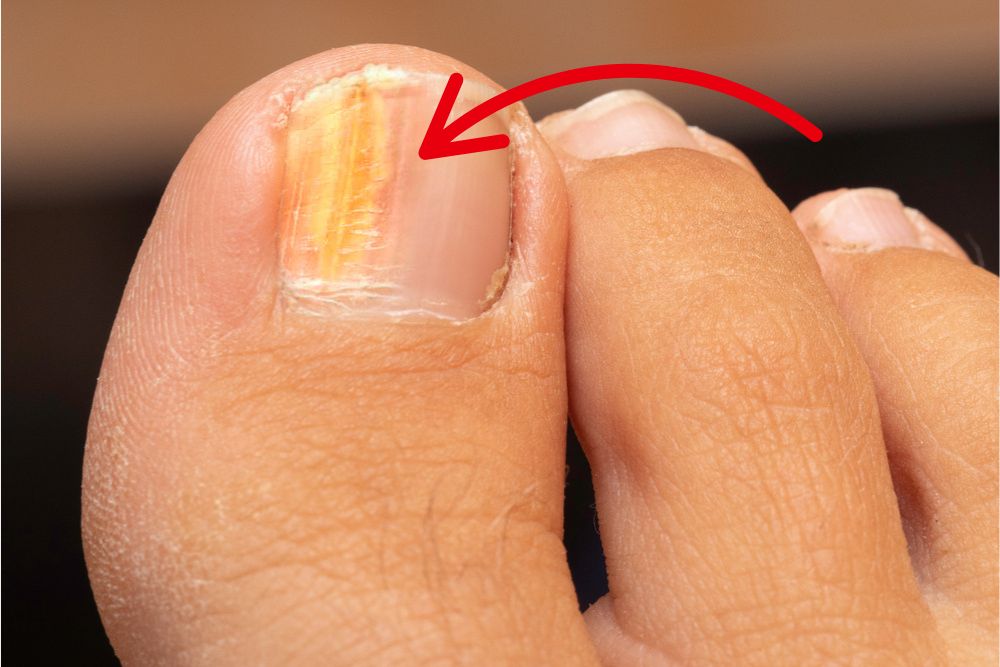Yellow toenails might seem like just a cosmetic issue, but they often signal something deeper happening with your nail health or overall hygiene. Whether it’s from a persistent fungal infection, years of nail polish use, or even an underlying health condition, yellow toenails can be both embarrassing and frustrating.
With the right care and a few natural tools, you can help restore your nails to a clearer, healthier appearance.

What Causes Yellow Toenails?
Here are the most common culprits:
1. Fungal Infections (Onychomycosis)
The #1 reason behind yellow, thickened, or crumbly toenails. Fungal infections thrive in warm, damp environments (think: sweaty socks or public showers), making your feet a prime target [1].
Signs of nail fungus include:
- Yellow, white, or brown discoloration
- Thickening or warping of the nail
- Brittleness or crumbling edges
2. Nail Polish Staining
If you regularly use dark nail polishes without a protective base coat, pigment can seep into the nail plate, leaving a yellowish hue behind. This type of staining is cosmetic and typically resolves with time.
3. Aging and Slowed Circulation
As we age, nail growth slows and circulation may decline, reducing the delivery of nutrients and oxygen to the nail bed. This can cause nails to appear dull or discolored.
4. Underlying Health Conditions
In rare cases, yellow nails may be a warning sign of:
- Diabetes
- Psoriasis
- Thyroid issues
- Yellow Nail Syndrome (a condition linked to lymphedema and respiratory issues)
If yellowing affects multiple nails or comes with swelling or discomfort, it’s best to check in with a healthcare provider.
Natural Ways to Fix Yellow Toenails
Looking for natural, at-home solutions? These remedies may help improve nail appearance and support healthy growth:
Tea Tree Oil
One of the most researched natural antifungals. Apply diluted tea tree oil directly to the nail 1–2 times daily to discourage fungal growth [2].
Oregano or Eucalyptus Oil
These oils contain natural compounds with antifungal properties. Oregano oil in particular has shown antifungal activity in lab settings against Candida species [3].
Baking Soda Scrubs
Baking soda is mildly abrasive and may help gently exfoliate stained nails while absorbing moisture from the nail bed. Some in vitro studies suggest baking soda may have antifungal properties [4], although more research is needed.
Apple Cider Vinegar (ACV) Soaks
ACV creates an acidic environment that makes it harder for fungus to thrive. Mix equal parts ACV and water, and soak feet for 15–20 minutes several times a week. Some studies suggest ACV has antifungal properties and may inhibit the growth of certain fungal species [5].
Don’t Forget Prevention
To avoid yellowing from coming back:
- Wear breathable shoes and change socks often
- Use antifungal foot powder in humid environments
- Disinfect nail tools and avoid sharing clippers
- Trim nails straight across and don’t cut too close to the skin
Final Thoughts
Yellow toenails are common, but they don’t have to be permanent. By addressing both external triggers and your internal environment, you can take real steps toward clearer, stronger, and healthier nails. Natural remedies, good hygiene, and a little patience go a long way.
If discoloration persists or worsens, don’t hesitate to consult a healthcare professional for deeper insights.
References:
- Lipner, S.R., Scher, R.K. (2019). Onychomycosis: Clinical Overview and Diagnosis. Journal of the American Academy of Dermatology, 80(4), 835-851. https://pubmed.ncbi.nlm.nih.gov/29959961/
- Hammer, K.A., Carson, C.F., Riley, T.V. (2003). Antifungal effects of Melaleuca alternifolia (tea tree) oil and its components on Candida albicans. Microbios, 82(332), 181-190. https://pubmed.ncbi.nlm.nih.gov/16418522/
- Cleff, M.B., Meinerz, A.R., Xavier, M., Schuch, L.F., Meireles, C.A., Rodrigues, M.R.A., de Mello, J.R.B. (2010). In vitro activity of Origanum vulgare essential oil against Candida species. Brazilian Journal of Microbiology, 41(1), 116–123. https://www.ncbi.nlm.nih.gov/pmc/articles/PMC3768597/
- Arendrup, M.C., Verweij, P.E., et al. (2012). Antifungal activity of sodium bicarbonate against common fungal pathogens. Mycopathologia, 174(5–6), 393–398. https://pubmed.ncbi.nlm.nih.gov/22991095/
- Yagnik, D., Serafin, V., Jadhav, S. (2018). Antimicrobial activity of apple cider vinegar against Escherichia coli, Staphylococcus aureus and Candida albicans; downregulating cytokine and microbial protein expression. Scientific Reports on ResearchGate. https://www.researchgate.net/publication/322766326





